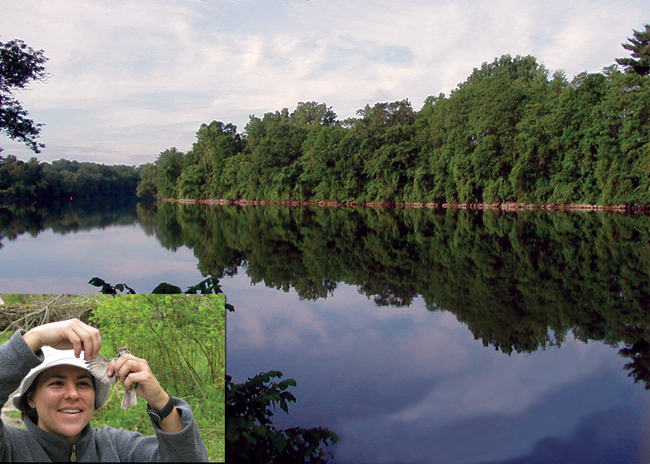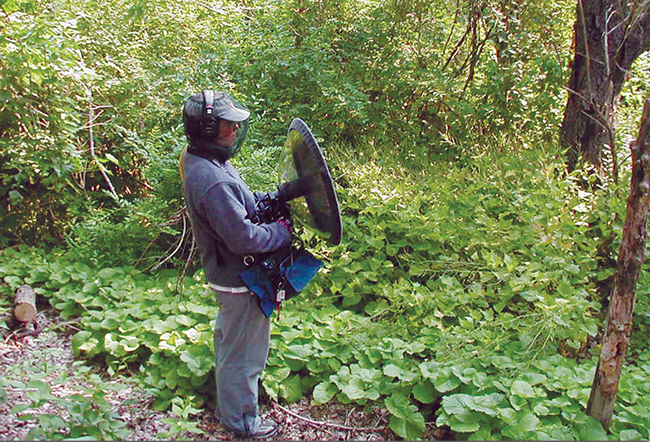Note: Hear some of the songs of birds featured in this article. See the Web Extras feature below.
Picture a hushed woodland along a Hudson riverbank. The silence is broken by a tiny blackcapped chickadee calling “fee-bee, fee-bee,” the spring song familiar to hikers and birders alike. Could this bird ever sing a different tune? A researcher at Cornell University’s Laboratory of Ornithology has found that in some environments the chickadee’s song has become variable and the sound of the first note inconsistent. The hypothesized cause of such variability may be non-lethal levels of contaminants that persist in the Hudson River region.
As a grad student at Cornell University’s Laboratory of Ornithology, Sara DeLeon’s interest in bird behavior got her involved with a NY Sea Grant funded project to study birdsong as an indicator of effects of exposure to sublethal levels of contaminants such as PCBs (polychlorinated biphenyls) in the environment. Principal investigator
Dr. Timothy J. DeVoogd, with a specialty in neuroanatomy and histology, really helped her “test her wings” as she learned about the intricacies of a bird’s brain. Co-investigator
Dr. André A. Dhondt, Sara’s advisor, encouraged her to find ways to best study birds both in the wild and in the lab.
Songbirds such as black-capped chickadees, red-winged blackbirds and song sparrows are common to New York State. Many nest along the Hudson River valley, a region with legacy levels of PCBs as a result of decades of electronics manufacturing upriver. During the last century, PCBs emerged as harmful, worldwide chemical pollutants. Most research on their biological consequences emphasized impacts on mortality, survival, and growth. Less studied has been the impact of prolonged exposure to sublethal levels of PCBs on animals.
Songbirds feed their chicks aquatic insects as a main food source, some of which may be contaminated by PCBs. Some birds continue eating insects throughout life, thus increasing PCB ingestion if they live in contaminated areas. In preliminary lab studies, the Cornell group found that PCBs interfere with the development of brain systems involved in producing song, and that some song characteristics are altered in birds living near Hudson River areas contaminated with PCBs. Because of the chemical structure and physiological effects of PCBs, one sublethal consequence could be alterations to bird behaviors. There are 209 different PCB molecules based on where the chlorine atoms are attached to each benzene ring. Different PCBs may have different effects on brain structures responsible for song in songbirds.

Sara DeLeon, a grad student at Cornell University’s Laboratory of Ornithology, studied birdsong as an indicator of effects of exposure to sublethal levels of contaminants such as PCBs (polychlorinated biphenyls) in the environment of the Hudson Valley. Photos courtesy of Sara DeLeon
Armed with binoculars and recording equipment, Sara set out into locations along the Hudson to record the songs of blackcapped chickadees (
Poecile atricapillus) and song sparrows (
Melospiza melodia). She also compared PCB concentrations in the birds using non-destructive techniques by taking samples of blood and feathers. Results showed that black-capped chickadees and song sparrows from regions with higher historic PCB contamination have higher blood PCB loads. Those regions with higher PCB levels showed a higher proportion of black-capped chickadees with variable songs and a higher proportion of song sparrows with high performance trills.
Black-capped chickadees have a basic twonote song consisting of just one high note (“fee”) and lower note (“bee”) Analysis of blood samples from black-capped chickadees showed that they have more PCB molecules with a high number of chlorine atoms and show greater variability in song with a change in the “glissando” ratio of the first note.
Song sparrows have a very long song with trills. The ‘high performance trills’ in song sparrows may be the result of other types of PCB molecules that are less toxic and act more like hormones. Some of the song sparrows with higher PCBs had slower trills. So those showing the high performance trills must have offset the slow trill rate with a larger bandwidth to get that high performance trill.
To corroborate results, DeLeon’s field studies were compared to controlled laboratory experiments to show the effect of PCBs on song using zebra finches (
Taeniopygia guttata). Zebra finches were dosed with minute quantities of PCB 52 (a known estrogenic mimic) and Aroclor 1242 (a commercial PCB mixture that was released on the Hudson River). “In the lab, zebra finches got a fraction of the PCBs they might be exposed to in the field, yet small amounts of contaminants were enough to have an effect.”
Results indicate that PCBs affect song characteristics, mating behavior, reproduction, song preference, and brain anatomy. Therefore, PCBs are changing a vital component of communication and reproductive success in birds, their song. (
Listen to actual birdsongs on this page - see "Related Info" sidebar for links)
What result is of the most interest to people? “Contaminants last a long time and are pervasive,” says DeLeon. “We have to take that into account when we study species in these disturbed environments and be aware of how environmental changes are affecting them.”
Several papers resulting from this project are in the works.
After seven years working on birdsong and behavior, Sara is now a post-doc at Drexel University in Philadelphia where she will continue working on bird behavior, this time on interactions between tropical birds and army ants.

Sara DeLeon in the field along the Hudson records the songs of black-capped chickadees (Poecile atricapillus) and song sparrows (Melospica melodia). Photo courtesy of Sara DeLeon
– Barbara A. Branca
Web Extras: Bird Songs
Files courtesy of Sara DeLeon
PCBs with a different molecular configuration appear to accumulate in the brains of song sparrows, increasing the performance of the long trills in their songs.
These two files compare a "consistent" call of a black-capped chickadee with a less consistent call which is associated with exposure to sublethal level of contaminants.